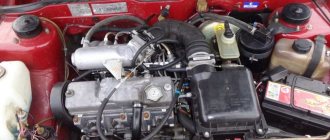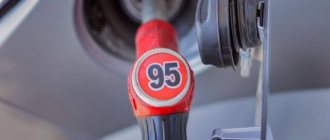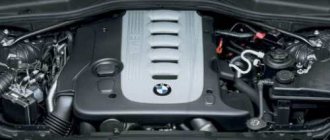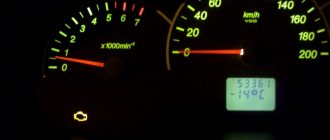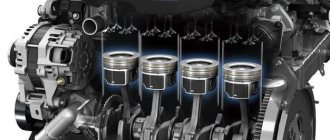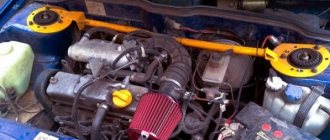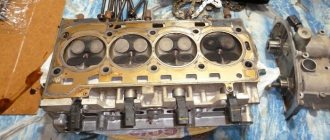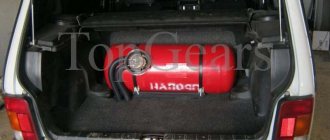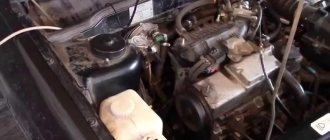As you know, installing gas equipment is practically the only way to reduce fuel costs in the case of gasoline cars. The main advantage is the more affordable price of gas compared to gasoline or diesel fuel.
However, even taking into account the fact that gas equipment is a reliable and trusted solution, and is constantly being improved by the manufacturers themselves, the possibility of various problems should not be ruled out.
The result is unstable engine operation; the driver notes that the engine is running rough on gas, although the unit can operate normally on gasoline. Also, quite often, along with tripping, gas consumption increases, throttle response and traction disappear. In some cases, a “check” may light up on the dashboard. Next, we will look at common reasons why a gas engine stalls.
Reasons why the engine “troubles”
The engine may throb constantly or from time to time. General signs of engine vibration are as follows: at idle speed, strong uneven vibrations begin to penetrate from the engine compartment into the cabin, the sound of the running engine changes (it “growls”, goes from high “notes” to low ones, and back).
The unit begins to consume more fuel, and its power decreases, and obscene sounds are heard from the exhaust pipe, accompanied by thick white or black smoke. If at least one of these signs is present, it means that the “heart” of your car has problems with one or more cylinders.
If they are not eliminated in time, the consequences can be very disastrous - up to and including a major overhaul of the power unit. Let's characterize the most common reasons why an engine stalls - there are four of them:
- late or early ignition of the air-fuel mixture (FA);
- uneven entry of fuel into the engine cylinder;
- lack or excess of air in the combustion chamber of the cylinder;
- drop in compression level.
Reason #1
. If the air-fuel mixture ignites in the cylinder earlier or later than the specified period, then the spark plugs are to blame, which produce too weak a spark, or the formation of a spark occurs untimely. Weak sparking occurs due to the fact that harmful deposits (carbon deposits) accumulate on the spark plug body and its electrodes, which interfere with spark breakdown.
Another reason for a weak spark is the destruction of its insulator.
In the place where the insulator has collapsed, a soot spot forms, which prevents the formation of a normal spark. If there is no spark at all, then there may be several reasons: a worn spark plug cap, a failed high-voltage wire (supplies current to the spark plug), a breakdown of the ignition coils or switch.
The latter phenomenon is quite rare, but it would not be superfluous to check the condition of the switch, which controls the ignition distribution.
Reason #2
. Uneven entry of fuel into the cylinder, when a smaller amount of gasoline or diesel is poured into the combustion chamber, often occurs due to a malfunction of the fuel pump parts (pressure part or pressure reducing valve) or the pressure valve in the fuel supply system.
If more fuel than necessary gets into the cylinder, the problem probably lies in the fuel injectors - they are dirty or out of order.
Finally, another “fuel” reason for engine throttling is a malfunction of the electronic control unit (ECU) of the power unit, which can erroneously increase or decrease the supply of gasoline/diesel to the cylinder.
Reason #3
. Excess air in the cylinder is a sign of depressurization of the air supply system, which includes the air filter, intake pipe hose, throttle pipe and receiver. A lack of this important component of the air-fuel mixture in the cylinder can be caused by a dirty air filter or broken throttle valves.
A malfunction of the mass air flow sensor or throttle position sensor, which the ECU perceives as a request from the engine to add or reduce the amount of air into the combustion chamber, can also cause the engine to trip.
Reason #4
. Low compression or its complete absence is perhaps the most serious reason why an engine misfires. This is the first sign that the pistons or valve in an idle cylinder are burnt out, or the piston rings are completely worn out. This cannot be done without serious repairs to the power unit.
In addition to the common reasons why an engine misfires, there are also secondary ones. They are spoken of when the engine starts to run periodically - “cold” (at idle speed) or “hot” (at medium or high speed).
The most common malfunction here is the valves: when their gap increases at idle speed, the engine trips, which goes away as it warms up (the gap is restored). And vice versa, the gap increases when the engine reaches operating temperatures - that’s when it starts “hot” with all the signs described above.
Diagnostic methods
If all the signs that the engine is malfunctioning are present, it is necessary to diagnose it and determine which cylinder has failed and for what reason. You can carry out the check yourself, or you can take the car to a service station, where its power unit will be subjected to detailed computer diagnostics.
In most cases, you can determine the reason for the engine tripping yourself, but if the cylinder refuses to work, for example, due to low compression, it is better to seek help from an experienced mechanic.
Step 1.
Determine the problem cylinder. We check the operation of the cylinders with the engine running, so all safety measures must be observed. We turn on the ignition, open the hood, listen to the engine. We remember what sound it works with. We begin to disconnect the high-voltage wires going to the spark plugs one by one.
When the working cylinder is turned off, the engine begins to rev with double force. If you disconnect the spark plug on the non-working cylinder, the behavior of the engine will not change. Another way is to not touch the high-voltage wires, but one by one turn off the chips that control the supply of fuel from the injectors to the cylinders.
If one of the chips is turned off, the operation of the engine will not change - this is how we detect a malfunctioning cylinder.
Step 2.
We check the condition of the high-voltage wire and spark plug. We disconnect the high-voltage wire and carefully inspect it. If we notice damage to the insulating layer, it means that the cause of the malfunction is in the wire.
It would also be useful to check the integrity of the current-carrying core - if it is broken or burnt out, then a breakdown or internal resistance occurs (we measure it with a multimeter, check it with normal readings), which interferes with the normal supply of current to the spark plug.
Let's sum it up
Listed above are the most common reasons why the engine stalls on gas. At the same time, there are also a number of other failures and breakdowns that lead to uneven operation of the engine at idle, under load, “cold” or “hot”. Often, without the proper experience and professional equipment, it is quite difficult to eliminate a non-obvious cause with your own hands.
It is also important to trust the installation only to experienced gas workers and qualified specialists, since incorrect installation and configuration of gas equipment can lead not only to incorrect operation and rapid failure of gas equipment, but also to serious consequences for the engine (including major repairs).
Even during operation, it is important to remember that LPG requires scheduled maintenance, like any other system in a car. It is necessary to promptly change gas filters, clean the gearbox, etc. In parallel, after switching to gas, you need to correctly select a separate oil for gas engines for your car, regularly change spark plugs, etc.
Why does the engine run rough on gas, but runs smoothly on gasoline?
The problem when the engine stalls is familiar to many motorists and, most often, each of you knows where you need to “dig” to understand the cause of this breakdown. However, in the case of gas equipment, not everything is so simple, and sometimes in order to understand why the engine is running on gas, you have to suffer for a very long time in search of a probable cause.
The main problem is that the design of gas equipment is not known to everyone; in addition, the search process is complicated by the fear of the gas itself, which, as you know, is a flammable substance. In this article I will try to understand the problem when the engine runs rough on gas , but works fine on gasoline.
The engine runs fine on gas, but runs fine on gasoline - reasons
The easiest and most correct way to look for the reason why the engine is shaking on gas is to connect a diagnostic scanner. With its help, you can find out exactly the cause of the malfunction based on the error recorded in the ECU. However, if there is no scanner or you do not have the opportunity to visit the gas workers, you can try to find the cause of the breakdown at random.
1. Check gas filters. If you have replaced gas filters a long time ago, it would be a good idea to check their condition and replace them if necessary.
2. If replacing gas filters does not lead to anything, we continue our search. Check the condition of the spark plugs; often the engine stalls and stalls on gas precisely because of problems with the spark plugs.
3. BB wires. High-voltage wires can cause tripping, but in this case, most likely, the engine will run unevenly on gasoline.
4. Gas reducer. If the gas reducer is configured incorrectly or is very dirty, it is quite possible that this kind of trouble will occur (idle speed floats, jerks while running on gas, engine roughness ).
Clean the gas reducer, replace filters and, if necessary, replace worn rubber gaskets, this will require a repair belt. kit for the corresponding gearbox.
In some cases, it may be necessary to completely replace the gas reducer.
5. Gas injectors. A problem with injectors can often manifest itself in the form of tripping. Due to malfunctions of the injectors, ignition of the gas mixture occurs intermittently, as a result, gas consumption increases, the engine suffers, and detonation is also possible.
A common problem with injectors is the so-called “non-holding”. You can check this on a diagnostic stand or at home, having some experience.
Why should problems be fixed immediately?
Gas equipment for injection and carburetor cars, even the best brands, wears out after some time. There are high risks of errors during installation and settings, which ultimately lead to malfunction of the 4th generation gas equipment. Errors during the installation of Tartarini LPG usually appear within the first week of operation.
Failures occur in propane-butane plants and methane-fired plants. When car owners understand gas system problems, issues are resolved faster and cheaper.
The first “bells” appear when filling with gas, when the solenoid valve closes too early and the indicator incorrectly shows the gas level. The operation of the cooling and heating system may be disrupted, the check light is on, the power drops, and if there is gas in the cylinder, the system itself switches to gasoline. The car owner is faced with worn-out injectors, a malfunction of the pressure sensor, gearbox, or a faulty map sensor. Ignoring the “Check Engine” signal leads to burnout of the valve seats.
When converting a car to Euro 4 gas, alpha gas equipment malfunctions largely depend on the professionalism of the technician. Therefore, it is recommended to contact only trusted car services.
Some HBO malfunctions can be repaired with your own hands. If the causes of the malfunction of the 4th generation gas equipment are eliminated initially, the costs are “penny”; in the future they will amount to tens of thousands of rubles.
The car runs on gas
In the life of every motorist there is a situation when the engine misfires, often this means a banal problem with the spark plug or a couple of other well-known breakdowns. But when it comes to the LPG system, sometimes it can be quite problematic to understand why the engine stalls on gas, but works fine on gasoline, and in this case one cannot do without an integrated approach and analysis of the situation. The car runs on gas for various reasons, but often, even a knowledgeable person is afraid to get into the gas installation and understand the problem, entrusting the troubleshooting to specialists.
In most cases, such caution when working with a gas system is justified, because gas is a flammable substance, and any leakage can result in serious problems. But if there is no opportunity to contact specialists, and the car stalls and stalls when running on gas, you can try to figure out the problem yourself.
Finding out the reasons
Let's try to highlight several reasons why your iron friend struggles on gas. To determine the cause, it is best to use a computer (laptop), connecting it through a special diagnostic cable to the electronic control unit of the gas system, if we are talking about the fourth generation of gas equipment and higher. If your car has a 2nd generation HBO or there is no way to connect a laptop, you will have to look for the reason the old fashioned way, eliminating step by step the weak points of the system.
HBO filters
First of all, you should check the gas filters; this advice is especially relevant if you have not done annual maintenance on your gas installation, and the car has been running on gas recently. We described in detail how to replace the LPG filter, drain the condensate and perform a complete maintenance of the system in this article.
Candles
The second weak point is the spark plugs. It is necessary to check the gap on the spark plugs, it should be the same on all spark plugs and be within the range of 0.7 -0.9. If scale is visible on a spark plug, this is a clear sign that it is “broken,” and the LPG system is not working on gas.
It is also worth noting that there are special spark plugs on sale that are designed specifically for engines that run on gas, it would be wise to purchase them.
Gearbox
One of the most common problems with an engine running on gas is contamination or incorrect adjustment of the system's gas reducer.
But in this case, the problem of a gas-powered car will include floating idle speeds, and jerks or loss of power when the engine is running on a gas installation. To begin with, try limiting yourself to cleaning the gearbox and replacing the filter in it (if there is one, of course).
If this does not help, you should take a closer look at the repair. kit that will fit your gearbox, and replace the used rubber gaskets in it.
Injectors
A fairly common problem that a car runs on gas but not on gasoline is gas injectors. There can be many reasons for the malfunction of injectors, ranging from their contamination and sticking to simple wear and tear of the design of one of them.
- To determine that the injectors are to blame for unstable engine operation on gas, the easiest way is to place them on a special diagnostic stand.
- The second option is to temporarily replace the injectors with a set that is known to work.
Sticky and dirty injectors can be washed, but worn ones will have to be replaced. To be fair, it is worth noting that quite often technicians at service stations, in case of wear of the injectors, suggest using a repair belt. kit, not new injectors. However, given that the price of rem.
kit fluctuates within 50% of the price of new injectors, and considering the cost of work to replace worn-out elements, agreeing to such an offer or buying new parts is not an easy choice.
You should also remember the fact that serviced injectors should be serviced at least once every 30,000 km. Maintenance consists of replacing damper rings and other worn elements. Remember that after replacing the injectors, a specialist must calibrate them and configure the system while the car is moving.
Wires
The last of the most common reasons is wear of high-voltage wires, but in this case the machine will not only run on gas, but also when running on gasoline.
Air leak
Leaky or loose gas system connections can cause air leaks, which in turn will lead to loss of power and unstable engine operation.
In conclusion, I would like to note that we have identified only the most common reasons that a car stalls on gas, in reality there are many more reasons, and if you were unable to identify the fault yourself, you should contact a qualified technician who will carry out diagnostics and accurately determine and will fix the problem.
see also
Comments 40
good day, when accelerating it also troits, if you accelerate well, the silencer shoots, everything seems to run fine on gasoline. The idle is smooth on both gas and petrol. I also have to figure it out(((
The solution was to replace the ignition coil. As a wire option (check), reducing the gap on the spark plugs gave a temporary effect.
I have exactly the same problem, changed the spark plugs, drove 300 km, same problem, someone says there are rubber seals in the gas injectors, you have a coil
everything was resolved by replacing the ignition coil, everything else gave a temporary effect!
It is possible that after a mileage of 150 to 300 km, the membrane in the gearbox sags. I had this happen, I drove up, adjusted the pressure in the gearbox and that’s it.
But the wires were not mixed up, they were just powered differently.
The hose was probably just pinched
So gentlemen. The trouble seems to have been resolved. I went to the installers today. I pointed out these problems, I don’t know how to say it correctly, in general they repowered it differently, the tripping went away, it doesn’t twitch at idle, the checkbox doesn’t light up. Thanks to all.
Idk. If I go to zero, I’ll push them around. Can anyone suggest an intelligent diagnostician in Kyiv?
I also had the wires from the injectors mixed up! And you need to change the spark plugs!
The spark plugs were changed... the wires too... It became better but by 50%. The check is on. The tuners say that the mixture may be lean. The consumption is the same as on gasoline. Traction too. I would like to remove the error and tripping.
check if the hose that goes from the rack to the manifold is pinched
When installing the HBO4 digitronic, the wires to the injectors were mixed up and I had similar problems... by the way, this problem was found out not by my installer, but by a third party, who joined the brains of the HBO... for me it was expressed this way - when starting smoothly from a traffic light, the engine worked intermittently (like as if it was missing something), with the air conditioner on and in the parking lot, the engine could stall... it went along the highway normally for a while, then twitching began...
I had similar symptoms. At first it worked fine on gas, but troubled on gasoline. Then it started to triple on gas, and doubled on gasoline. Then the gas stopped working altogether... In general, a glass of greenish liquid was poured out of the brain case, the entire board was covered with an oxide the consistency of sea-green yogurt
